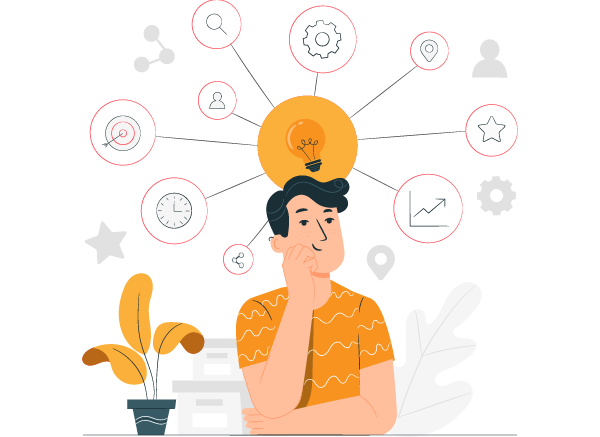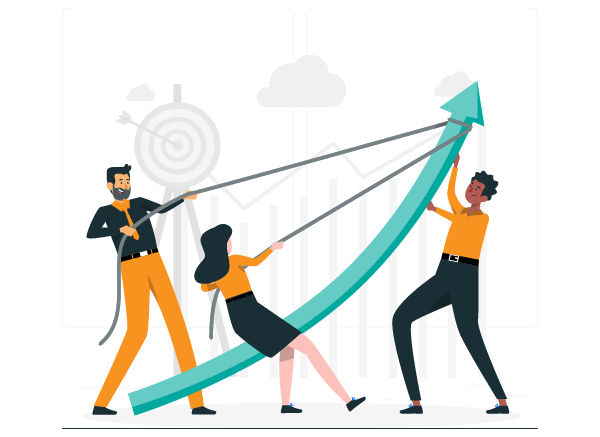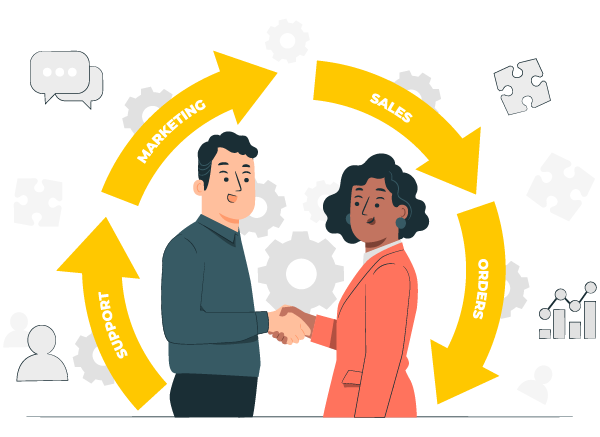
Are you ready to kickstart your transformation journey? In this section, we’ll show you how to do just enough preparation to ensure a successful start.
Firstly, we’ll reveal the secrets to getting management aligned around the objectives, so everyone is moving in the same direction. Then, we’ll dive into identifying what needs to change, uncovering the hidden roadblocks and obstacles, so you can overcome them with ease.
But that’s not all – we’ll also walk you through defining your product, giving you a crystal-clear vision of what you’re working towards. And finally, we’ll show you how to identify the crucial organizational elements to form the perfect product group, ensuring you have the right people in the right roles to bring your vision to life.
So what are you waiting for? Let’s get started on your transformation journey and turn your plans into reality!
Areas of Concern for Successful Preparation
Many of the activities occur in parallel, some of them happen before the product group launch, and some might happen later. In some contexts, you might consider some activities irrelevant. During the preparation phase, several areas of concern should be covered:
- Area 1: Involve the managers.
- Area 2: Understand the current reality.
- Area 3: Create a vision of the future.
- Area 4: Identify the product group.

Figure 1: areas of concerns
Area 1: Involve the Managers
It is difficult to redesign organization to improve Agility without senior management support, because these executives have the authority to change the system of work and resolve organizational impediments. According to the research of Richard Hackman and Ruth Wageman, 60% of the teams’ success depends on the team’s design.
The team’s design (compelling purpose, real teams, solid structure, supportive organizational context, right people) contributes to 60% of success.
According to John Seddon,
Culture change is free—people’s behavior is a product of the system in which they work.
Educating Management to Change Their Mental Models
From systems thinking theory, we know that the organizational design is derived from the managers’ mental models—their perceptions of reality and their beliefs. And that’s also why organizational coaching should start with the education of the senior managers. Some education topics you might consider:
- Agile fundamentals
- Organizational design
- Systems thinking
- Complex systems
- Queueing theory
- Lean thinking
- Scrum framework
- Multiple-team Scrum
- Measures
- Growing people and teams
Getting Sufficient Managers’ Support
There is no rigid rule on how to define how much support is “enough.” Use your own intuition. Nevertheless, if you believe that the current level of support does not provide for enough structural changes for the adoption to succeed, continue working with the managers. Table 1 is a checklist that includes both team design and supportive organizational context elements. Make sure that management is ready to support most of the items listed in the right column.
| Unsupportive Start Situation | Supportive Start Situation |
| Teams organized around product parts or siloed functions | Teams are organized around end-user features, products. or services that are purchased by the customers on the market (independent profit-and-loss [P&L] units) |
| Team members work in different locations | Team members physically sit in the same room, preferably around one large table |
| Hierarchy inside the teams (team managers, team product owners) | Team of peers; no hierarchy’, the only title is Developer |
| The Product Owner, who has no real power, does not own the budget and cannot make strategic product decisions | The Product Owner is the product’s CEO, with full ownership of the product |
| Internal contracts between the business and development department are in action, with deadlines and commitments | Business and developers work in the same business unit and success is measured by delivered value as assessed against established business criteria (e.g., profit, customer satisfaction, employee satisfaction,social impact) |
| Team members have functional managers who can influence their salary, vacation, and other rewards | Team members have cross-functional managers |
| There is a policy to rotate or regroup people frequently; the team composition is unstable | The team is stable, its core members stay for at least 1–3 years |
We urge you not to compromise on the Agile values and principles. We urge you not to take the safe route. Remember that your role as an organizational coach is to challenge the status quo and drive significant change and business results.
Area 2: Understand the Current Reality
Too often, people start an Agile transformation without a deep appreciation of the current reality. They don’t understand the deep reasons why the organization operates the way it does and how that created the current performance. To find the areas of highest leverage, we need to carefully investigate the Gemba, which means “actual place”, the place of value creation, in Japanese. Only when you truly understand your current state can you begin to make good decisions about organizational structure, roles and responsibilities.
A few tools and practices that we use regularly while investigating the Gemba:
- Go See
- Individual interviews
- Value stream mapping
- Scott Morton diagram
- Weighted SWOT and confrontational matrix
- Finding system structures workshop
Area 3: Create a Vision of the Future
It is crucial to align the management and the teams on the business objectives that they want to achieve with the transformation. Alignment creates a clear goal and focus. People remember— when times get hard—why there is a transformation in progress. A clear understanding of the gap between the current situation and the desired objectives creates a force to bring them together.
Alignment is a process that can take numerous workshops spread out over many weeks to fully achieve a shared understanding.
The main focus areas of the workshops are:
- A shared understanding of the objectives that are aimed for: the Shared Objectives Workshop
- A shared expression of the team expectations to be met: the Shared Team Expectations Workshop
- Definition of the organizational design optimizing goals: the Shared Optimizing Goals Workshop
- A definition of the perfection state: the Perfection Vision Workshop
Description Of The Shared Objectives Workshop
Any leadership team that leads the transformation needs to be able to share the reason and objectives
for the transformation with the people involved—Peter Senge calls it the “shared vision” in his book The Fifth Discipline.8 The shared goals bring into alignment the vision and the efforts of the organization’s people. They create the conditions that enable process design, work design, and system-wide problem solving to flow in the same direction. The alignment is on what to move away and what to move toward.
To empower people in an unaligned organization can be counterproductive.
Objectives are the specific results you want to accomplish within a particular time frame. Most
objectives in our experience are related to one or more of the following:
- Decreased concept-to-delivery cycle time
- Increased financial results
- Increased employee satisfaction
- Cost reduction
- Increased customer satisfaction
- Improved reliability of service and product delivery
- The idea is to find an organizational design that enables the company to achieve its objectives and expectations.
Area 4: Identify the Product Group
In this step, you create a unit for a real product or service, while avoiding so-called internal products. A product group operates semi-autonomously within the larger organization and is measured on its financial performance. Of particular importance is the principle of revealing the reciprocal dependencies and containing them inside the product group. As a refresher, reciprocal dependencies are frequently encountered two-way interdependencies between the work of different units.
A systems approach considers the whole first, and then improves the parts only if doing so also improves the whole. The whole, in our case, is the product, and the parts are the teams and departments. We use the Product definition as the starting point.
What Is a Product?
A commonly used definition of a product is “something that is made to be sold.”
A product is anything that can be offered to a market that might satisfy a want or need.
We use this definition and augment that with the following product properties:
- A product has users who are people.
- A product provides features to those users that address their needs and problems.
- A product has a business model; revenue stream, independent profit and loss (P&L) results, or return on investment (ROI).
- A product is developed and sustained by a system of people, components, and processes.
Here are some examples of products from our clients:
- Energy trading system
- Surface radar
- Core banking services
And here are some examples of parts that aren’t really products:
- Platform
- Internal CRM system
- Credit conveyor process
In large organizations, it is common to have a few internal products (often called shared services), and that is perfectly fine—as long as the majority of the company’s outputs are real products.
Two Product Perspectives
The product definition that marketing uses might not be the same as the product definition used by the development group, and that is perfectly okay. From a development perspective, the product definition is intended for optimizing adaptability and speed of learning so as to deliver value. From a marketing perspective, it might be beneficial to have a different product definition to address marketing goals.
Another example could be the various smartphone models (product family) that a company offers, as they are presented as separate products for the end consumers. Internally, however, the smartphones share a lot of their development components and might be defined as a single product.
How to Define the Product?
The product definition determines which organizational elements (people, components, processes, and systems) will be part of the first step in the transformation. You can define your product by following these steps:
- Step 1. Identify the key users and required outcomes.
- Step 2. Identify the end-to-end activities to deliver the required outcomes.
- Step 3. Identify required systems, groups, and individuals required to develop, maintain, and run the product.
- Step 4. Clarify the revenue stream. In this step, we ask the question: do the identified organizational elements generate revenue for the organization?

Figure 2: how to find a product
Organizational Design to Eliminate Dependencies
Some competencies are required more than others to develop the product features. We recommend using the features on the Product Backlog to study the dependencies. You should study the workflow (i.e., how the work works) and determine which organizational elements are needed to develop the features. The more often a particular element is required, the stronger the dependency is. We visualize this with a heat map.
The heat map has two dimensions. The y-axis shows the key features that you expect to develop. The x-axis shows the needed components and systems to create and sustain those features. In Figure 3, the Web component is used 13 times and the App component is used 9 times. The components that heat up the most—the hotspots—indicate the most frequently encountered type of work.

Figure 3: heat map
When a team can work on all components but only one feature—that is, a team covers a complete row, then the team is optimized for delivery speed at the single feature level but cannot adapt to work on other features.
In contrast, when a team covers all features but only one component, that team covers a complete column in the heat map. Such a team is optimized for adaptability at the local team level but cannot work on other components to produce a complete feature. Neither of these team configurations is particularly useful.
Therefore, the size of the heat map area that a team covers strongly determines its:
- Feature delivery speed
- Flexibility to pick up work from the Product Backlog
The optimal starting configuration is the largest area in the heat map that can be covered by all teams from the start. The challenge is to find the optimal balance between speed and adaptability.
Value Areas
If your product is really large, use the Value Area pattern to reduce the cognitive load for developers. The main question is: “Which features do customers use most of the time?” When you answer this question, you will undoubtedly notice that certain groups use only a subset of the features most of the time. Those subsets are your value areas.
The next step is to find the appropriate balance between adaptability and speed by finding the biggest area that can be covered by the teams and still deliver value. As a rule of thumb, we use the following criteria:
- Maximize dependencies within a value area
- Contain reciprocal dependencies within one value area
- Ensure sequential dependencies between value areas
- Manage pooled dependencies across teams and value areas
Figure 4 shows the red area. The Pricing, Web, App, Siebel, and Portal components are used often
together, and their interdependencies are reciprocal.

Figure 4: red value area
Furthermore, you can see that the area has a pooled interdependencies with the Legal function, and that it is a relatively strong dependency. The weakest interdependency is with Sales Force. We chose not to include Sales Force initially and only added it when the teams mastered the other elements. The Legal function was also not included in the teams because it was a pooled dependency.
In summary,
Are you ready to embark on a journey of transformation and turn your plans into reality? To ensure successful preparation, there are several areas of concern that you should focus on. These include involving managers, understanding the current reality, creating a vision of the future, and identifying the product group.
Involving managers is crucial for improving agility and changing the system of work. It’s essential to educate senior managers to change their mental models and perceptions of reality.
To truly understand your current state, you need to investigate the Gemba or the actual place where value creation occurs. This involves using tools such as value stream mapping, individual interviews, and finding system structures workshop.
Creating a vision of the future is crucial to align management and teams on business objectives and achieve a shared understanding. This requires several workshops to define shared objectives, team expectations, organizational design optimizing goals, and perfection vision.
Identifying the product group is the next step, and it involves creating a unit for a real product or service that operates semi-autonomously within the larger organization. To eliminate dependencies, you need to study the workflow and determine which organizational elements are needed to develop product features. A heat map can be used to visualize the most frequently encountered type of work and identify areas for optimization.








